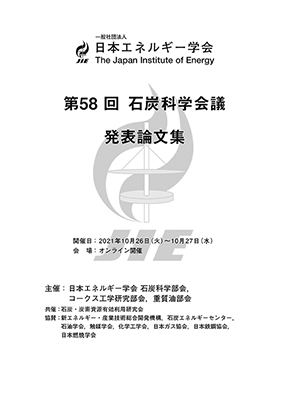第58回石炭科学会議
Displaying 1-40 of 40 articles from this issue
- |<
- <
- 1
- >
- >|
-
Pages 0_1-0_2
Published: October 19, 2021
Released on J-STAGE: November 08, 2021
Download PDF (263K) -
Pages 0_3-0_5
Published: October 19, 2021
Released on J-STAGE: November 08, 2021
Download PDF (260K)
-
Pages ii-xi
Published: October 19, 2021
Released on J-STAGE: November 08, 2021
Download PDF (631K) -
Pages xii-xxi
Published: October 19, 2021
Released on J-STAGE: November 08, 2021
Download PDF (713K) -
Pages xxii-xxix
Published: October 19, 2021
Released on J-STAGE: November 08, 2021
Download PDF (1635K) -
Pages xxx-xxxvi
Published: October 19, 2021
Released on J-STAGE: November 08, 2021
Download PDF (629K)
-
Pages 2-3
Published: October 19, 2021
Released on J-STAGE: November 08, 2021
Download PDF (687K) -
Pages 4-5
Published: October 19, 2021
Released on J-STAGE: November 08, 2021
Download PDF (604K) -
Pages 6-7
Published: October 19, 2021
Released on J-STAGE: November 08, 2021
Download PDF (809K) -
Pages 8-9
Published: October 19, 2021
Released on J-STAGE: November 08, 2021
Download PDF (765K)
-
Pages 10-11
Published: October 19, 2021
Released on J-STAGE: November 08, 2021
Download PDF (671K) -
Pages 12-13
Published: October 19, 2021
Released on J-STAGE: November 08, 2021
Download PDF (953K) -
Pages 14-15
Published: October 19, 2021
Released on J-STAGE: November 08, 2021
Download PDF (558K) -
Pages 16-17
Published: October 19, 2021
Released on J-STAGE: November 08, 2021
Download PDF (756K)
-
Pages 18-19
Published: October 19, 2021
Released on J-STAGE: November 08, 2021
Download PDF (557K) -
Pages 20-21
Published: October 19, 2021
Released on J-STAGE: November 08, 2021
Download PDF (925K) -
Pages 22-23
Published: October 19, 2021
Released on J-STAGE: November 08, 2021
Download PDF (535K)
-
Pages 24-25
Published: October 19, 2021
Released on J-STAGE: November 08, 2021
Download PDF (531K) -
Pages 26-27
Published: October 19, 2021
Released on J-STAGE: November 08, 2021
Download PDF (615K) -
Pages 28-29
Published: October 19, 2021
Released on J-STAGE: November 08, 2021
Download PDF (907K) -
Pages 30-31
Published: October 19, 2021
Released on J-STAGE: November 08, 2021
Download PDF (564K)
-
Pages 32-33
Published: October 19, 2021
Released on J-STAGE: November 08, 2021
Download PDF (741K) -
Pages 34-35
Published: October 19, 2021
Released on J-STAGE: November 08, 2021
Download PDF (958K) -
Pages 36-37
Published: October 19, 2021
Released on J-STAGE: November 08, 2021
Download PDF (651K) -
Pages 38-39
Published: October 19, 2021
Released on J-STAGE: November 08, 2021
Download PDF (1123K)
-
Pages 40-41
Published: October 19, 2021
Released on J-STAGE: November 08, 2021
Download PDF (594K) -
Pages 42-43
Published: October 19, 2021
Released on J-STAGE: November 08, 2021
Download PDF (613K) -
Pages 44-45
Published: October 19, 2021
Released on J-STAGE: November 08, 2021
Download PDF (383K)
-
Pages 46-47
Published: October 19, 2021
Released on J-STAGE: November 08, 2021
Download PDF (1045K) -
Pages 48-49
Published: October 19, 2021
Released on J-STAGE: November 08, 2021
Download PDF (609K) -
Pages 50-51
Published: October 19, 2021
Released on J-STAGE: November 08, 2021
Download PDF (655K) -
Pages 52-53
Published: October 19, 2021
Released on J-STAGE: November 08, 2021
Download PDF (808K)
-
Pages 54-55
Published: October 19, 2021
Released on J-STAGE: November 08, 2021
Download PDF (662K) -
Pages 56-57
Published: October 19, 2021
Released on J-STAGE: November 08, 2021
Download PDF (566K) -
Pages 58-59
Published: October 19, 2021
Released on J-STAGE: November 08, 2021
Download PDF (679K) -
Pages 60-61
Published: October 19, 2021
Released on J-STAGE: November 08, 2021
Download PDF (813K)
-
Pages 62-63
Published: October 19, 2021
Released on J-STAGE: November 08, 2021
Download PDF (659K) -
Pages 64-65
Published: October 19, 2021
Released on J-STAGE: November 08, 2021
Download PDF (675K) -
Pages 66-67
Published: October 19, 2021
Released on J-STAGE: November 08, 2021
Download PDF (710K) -
Pages 68-69
Published: October 19, 2021
Released on J-STAGE: November 08, 2021
Download PDF (660K)
- |<
- <
- 1
- >
- >|
